History

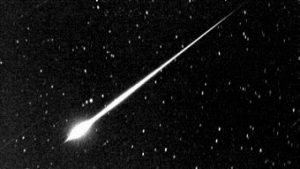 It was in the middle of World War I, on the 4th of July, 1917. The citizens of Colby, Wisconsin were busy celebrating Independence Day. Colby was originally famous for the making of Colby cheese, but it was about to be famous for something else entirely. Around 6:30, the people were setting of fireworks and everyone was having a great time, when suddenly, there was a louder-than-it-should-have-been explosion. The people were startled and began to speculate as to the origin. Some thought it was dynamite set off by some over-zealous celebrators. Then, they dismissed that thought, and some of the townspeople were concerned that when the went outside, they might see a Zeppelin dropping German bombs on the little town. In the end it turned out to be something form much further away…outer space to be exact.
It was in the middle of World War I, on the 4th of July, 1917. The citizens of Colby, Wisconsin were busy celebrating Independence Day. Colby was originally famous for the making of Colby cheese, but it was about to be famous for something else entirely. Around 6:30, the people were setting of fireworks and everyone was having a great time, when suddenly, there was a louder-than-it-should-have-been explosion. The people were startled and began to speculate as to the origin. Some thought it was dynamite set off by some over-zealous celebrators. Then, they dismissed that thought, and some of the townspeople were concerned that when the went outside, they might see a Zeppelin dropping German bombs on the little town. In the end it turned out to be something form much further away…outer space to be exact.
The streak through the sky could have been missed because of the fireworks, but the explosion was another thing entirely. The meteorite hit just west of the Zion Lutheran Church, which is still there on the corner of West Jefferson Street and North 2nd Street in Colby, Wisconsin. When the townspeople located it easily, due to the smoke trail in the sky. They found that it had broken into two pieces, with the smaller piece landing just a short distance from the church, imbedded to a depth of one foot. It weighed about 75 pounds, and was said the be intensely cold, forming frost on it when it was uncovered. The larger piece landed in Joseph Jordan’s field, imbedding itself to a depth of five feet. The depth made it difficult to dig up, so it was not unearthed until the next morning when Professor Williams secured it for a school exhibit. That piece weighed about 300 pounds, and was apparently not as cold, probably due to the time spent in the ground.
It was said that another piece had landed in Cornell, Wisconsin, which is about 60 miles away from Colby. Amazingly, none of the other small towns in the area were hit. The principal of the Colby High School assumed, 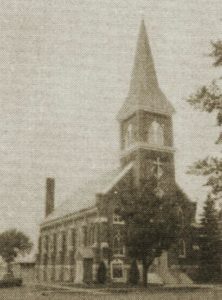 correctly as it turns out that there were likely to be other fragments too. He did some digging in the area, and is said to have found a sizeable collection of fragments. Of course, that makes sense, because as a meteor streaks through our atmosphere, the intense heat, impacting the intense cold usually causes them to break up long before they impact the Earth’s surface. Still, every so often, a particularly sturdy meteor slips through without being totally obliterated, and then we have a strike, such as the one in Colby, Wisconsin in 1917.
correctly as it turns out that there were likely to be other fragments too. He did some digging in the area, and is said to have found a sizeable collection of fragments. Of course, that makes sense, because as a meteor streaks through our atmosphere, the intense heat, impacting the intense cold usually causes them to break up long before they impact the Earth’s surface. Still, every so often, a particularly sturdy meteor slips through without being totally obliterated, and then we have a strike, such as the one in Colby, Wisconsin in 1917.
According to the Wisconsin Geological and Natural History Survey, there have been 13 documented meteorite strikes in Wisconsin since 1860. The latest one was in April 2010. Often, the way that meteorites are discovered is that someone finds a rare mineral rock, and when checked, the chemical makeup of the stone indicates that it may have originated in outer space. Of course, that doesn’t document when it happened, or if it was actually part of a documented strike. We always have been and probably always will be fascinated by the extraterrestrial.
 As we head into Independence Day 2020, many of us have begun to realize that this year, it’s different. Everything is different. The year, Independence Day has taken on a whole new meaning for me and so many others. For the first time in our nations history, almost everything was shut down. People were quarantined…leaving only the essential workers going to work, and the rest of us staying home, except for food, medicine, and doctor visits. Covid 19 had changed everything.
As we head into Independence Day 2020, many of us have begun to realize that this year, it’s different. Everything is different. The year, Independence Day has taken on a whole new meaning for me and so many others. For the first time in our nations history, almost everything was shut down. People were quarantined…leaving only the essential workers going to work, and the rest of us staying home, except for food, medicine, and doctor visits. Covid 19 had changed everything.
Spring Break for the schools brought the quarantine, and even if we had no children in school, we felt that change deeply. Everything just…stopped. Restaurants were closed, movies were out, bowling leagues ended early, as did all sports. Once the warmer weather hit, it felt like summer, but it was only May. This would prove to be the longest summer ever…I’m not complaining, mind you. Summer is my favorite time of year. I can’t imagine how awful it would have been, if the quarantine had happened in the Winter, when I wouldn’t have been able to get outside and walk on the trail near my home…especially since I am not into winter sports, and those places would have been closed anyway.
Finally after more than three months of quarantine, the states were allowed to begin reopening. Still, we did 
 not know what the summer would look like. Sports were up in the air, contemplating a shortened season, or as in the case of some, cancelling the 2020 season altogether. Graduations, funerals, birthday gatherings, and holidays were uncertain. Finally, as campgrounds and hotels began to reopen, it looked like summer might be salvaged. Still, several fairs and some 4th of July fireworks thought about, or did cancel. My husband, Bob and I usually go to the Black Hills over the 4th of July, to do some hiking, so this was a concern to us. Finally, word came down that the fireworks display we loved would indeed be held, and that after a 9 year span without fireworks at Mount Rushmore, that display would also take place this year. We were so happy, and booked our motel right away.
not know what the summer would look like. Sports were up in the air, contemplating a shortened season, or as in the case of some, cancelling the 2020 season altogether. Graduations, funerals, birthday gatherings, and holidays were uncertain. Finally, as campgrounds and hotels began to reopen, it looked like summer might be salvaged. Still, several fairs and some 4th of July fireworks thought about, or did cancel. My husband, Bob and I usually go to the Black Hills over the 4th of July, to do some hiking, so this was a concern to us. Finally, word came down that the fireworks display we loved would indeed be held, and that after a 9 year span without fireworks at Mount Rushmore, that display would also take place this year. We were so happy, and booked our motel right away.
As we prepare to watch the fireworks on Independence Day 2020, it comes to mind that Independence Day has taken on a whole new meaning. For a time, we lost our independence, and now we have it back. The feeling  reminds me of how the early settlers felt, when England finally gave up and we had won our independence from them. Yes, we still have a ways to go before we will have our country back to normal. During the lock-down, some bad things happened and some people are in an outraged state, but I believe that we will be able to get back to normal through the love of God being shown in our nation. There are those who want to change the root of our nation, but they will not succeed. We are and always will be “One Nation, Under God” and we will have victory over the anarchists. Today, we celebrate the birth of our great nation, the United States of America. It is with a whole new meaning…Freedom Again!! Happy Independence Day everyone, God bless you all, and God bless America!!
reminds me of how the early settlers felt, when England finally gave up and we had won our independence from them. Yes, we still have a ways to go before we will have our country back to normal. During the lock-down, some bad things happened and some people are in an outraged state, but I believe that we will be able to get back to normal through the love of God being shown in our nation. There are those who want to change the root of our nation, but they will not succeed. We are and always will be “One Nation, Under God” and we will have victory over the anarchists. Today, we celebrate the birth of our great nation, the United States of America. It is with a whole new meaning…Freedom Again!! Happy Independence Day everyone, God bless you all, and God bless America!!
 Sometimes an evil leader can come in and before anyone realizes it, the danger that came in with him is real. Unfortunately, not every elected leader is a good one, and when an elected leader, begins to do things like taking away the guns of the people and undermining the police, you find out just how bad they really are. Hitler was that kind of elected leader, and worse. By May of 1934, Hitler had been the chancellor of Germany for 16 months, and the dictator for 14 months. Less than a month after Adolf Hitler was appointed chancellor of Germany, he calls on elements of the Nazi party to act as auxiliary police. The SS (Schutzstaffel), initially Hitler’s bodyguards, and the SA (Sturmabteilung, the German Assault Division), who were the street fighters or Storm Troopers of the Nazi party, now operated as the private army of the Nazi party. SS chief Heinrich Himmler also turned the regular (nonparty) police forces into an instrument of terror. He helped forge the powerful Secret State Police (Geheime Staatspolizei), or Gestapo. These non-uniformed police used ruthless and cruel methods throughout Germany to identify and arrest political opponents and others who refused to obey laws and policies of the Nazi regime. It had taken less than a year to change everything for the people of Germany, who no longer had a say in their own lives.
Sometimes an evil leader can come in and before anyone realizes it, the danger that came in with him is real. Unfortunately, not every elected leader is a good one, and when an elected leader, begins to do things like taking away the guns of the people and undermining the police, you find out just how bad they really are. Hitler was that kind of elected leader, and worse. By May of 1934, Hitler had been the chancellor of Germany for 16 months, and the dictator for 14 months. Less than a month after Adolf Hitler was appointed chancellor of Germany, he calls on elements of the Nazi party to act as auxiliary police. The SS (Schutzstaffel), initially Hitler’s bodyguards, and the SA (Sturmabteilung, the German Assault Division), who were the street fighters or Storm Troopers of the Nazi party, now operated as the private army of the Nazi party. SS chief Heinrich Himmler also turned the regular (nonparty) police forces into an instrument of terror. He helped forge the powerful Secret State Police (Geheime Staatspolizei), or Gestapo. These non-uniformed police used ruthless and cruel methods throughout Germany to identify and arrest political opponents and others who refused to obey laws and policies of the Nazi regime. It had taken less than a year to change everything for the people of Germany, who no longer had a say in their own lives.
While he had control, it was still not enough for the insane chancellor. Hitler, as we all know, would go on to annihilate millions of the Jewish people, as well as anyone else he considered an “undesirable” person. While I’m sure the leaders of the German government considered themselves safe, they would find out just how wrong they were on the Night of the Long Knives…also known as a Blood Purge, or putsch in German. By definition, a blood purge is “the elimination en masse by massacre or execution of individuals considered to constitute an untrustworthy or undesirable element within a party or movement. the elimination en masse by massacre or execution of individuals considered to constitute an untrustworthy or undesirable element within a party.” Hitler had decided that some of his own leaders, his trusted associates, could not be trusted. Maybe he was right, but he didn’t really have proof of his doubts. Nevertheless, He decided that there needed to be a blood purge and the Night of the Long Knives was born.
On June 30, 1934, it began, and continued on until July 2, 1934. During the purge of the Night of the Long Knives (Nacht der langen Messer) Hitler and the Nazi regime used the Schutzstaffel (SS) to deal with the perceived problem of Ernst Röhm and his Sturmabteilung (SA) brownshirts (the original Nazi paramilitary organization). The first thing Hitler did was to take out…or defund the police. Believe it or not, that took out the 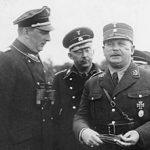 last protection of the people. He also took out past opponents of the party, thinking that they might organize against them. It is estimated that at least 85 people were murdered, but many historians think that the death toll was likely in the hundreds. Most of those killed were members of the SA, other victims included close associates of Vice Chancellor Franz von Papen, several Reichswehr (German Army) generals…one of whom, Kurt von Schleicher, was formerly the Chancellor of Germany. Hitler also took out their associates. Gregor Strasser, Hitler’s former competitor for control of the Nazi Party was the next to go. At least one person was killed in a case of mistaken identity, sadly, and several innocent victims were simply killed because they “knew too much.” The Night of the Long Knives…was Hitler’s insane revenge on anyone who dared to oppose him, or even to appear to oppose him.
last protection of the people. He also took out past opponents of the party, thinking that they might organize against them. It is estimated that at least 85 people were murdered, but many historians think that the death toll was likely in the hundreds. Most of those killed were members of the SA, other victims included close associates of Vice Chancellor Franz von Papen, several Reichswehr (German Army) generals…one of whom, Kurt von Schleicher, was formerly the Chancellor of Germany. Hitler also took out their associates. Gregor Strasser, Hitler’s former competitor for control of the Nazi Party was the next to go. At least one person was killed in a case of mistaken identity, sadly, and several innocent victims were simply killed because they “knew too much.” The Night of the Long Knives…was Hitler’s insane revenge on anyone who dared to oppose him, or even to appear to oppose him.
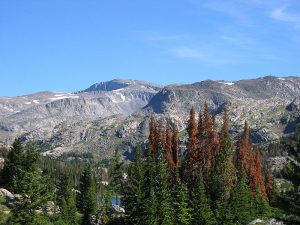
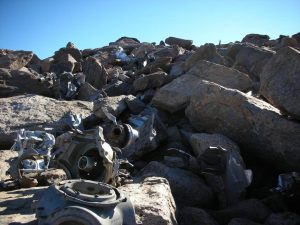 High up in the Big Horn Mountains, about 23 miles from Buffalo, Wyoming, rest the remains of a B-17F-55-DL Flying Fortress, serial number 42-3399, nicknamed “Scharazad.” The highest peak in the Big Horn Range is Cloud Peak, at an elevation of 12,840 feet. After the crash of the bomber, the next peak over, the one on which the bomber rests was renamed Bomber Mountain. The plane is still there today, but the bodies of the crew, William R Ronaghan (pilot), Anthony J Tilotta (co-pilot), Leonard H Phillips (navigator), Charles H Suppes (bombardier), James A Hinds (aircraft engineer), Ferguson T Bell Jr (radio operator), Lee ‘Vaughn’ Miller (assistant aircraft engineer), Charles E Newburn Jr (assistant radio operator), Jake F Penick (aircraft gunner), Lewis M Shepard (assistant aircraft gunner), were recovered from the crash site and given a proper burial.
High up in the Big Horn Mountains, about 23 miles from Buffalo, Wyoming, rest the remains of a B-17F-55-DL Flying Fortress, serial number 42-3399, nicknamed “Scharazad.” The highest peak in the Big Horn Range is Cloud Peak, at an elevation of 12,840 feet. After the crash of the bomber, the next peak over, the one on which the bomber rests was renamed Bomber Mountain. The plane is still there today, but the bodies of the crew, William R Ronaghan (pilot), Anthony J Tilotta (co-pilot), Leonard H Phillips (navigator), Charles H Suppes (bombardier), James A Hinds (aircraft engineer), Ferguson T Bell Jr (radio operator), Lee ‘Vaughn’ Miller (assistant aircraft engineer), Charles E Newburn Jr (assistant radio operator), Jake F Penick (aircraft gunner), Lewis M Shepard (assistant aircraft gunner), were recovered from the crash site and given a proper burial.
On June 28, 1943, the B-17F “Scharazad” left Pendleton, Oregon to join a bomber group headed to Europe during World War II. Around midnight, Captain Ronaghan radioed that their position was near Powder River, Wyoming. That was the last transmission, and they were never heard from again. The Army launched multiple search campaigns to find the missing plane among the mountains, but modern search aids like GPS were not available until the 1960s, and planes can be difficult to find in mountainous terrain anyway, due to trees and grasses blending with the green tones of the plane.
It would take two long years for the families of these fallen men to have closure, and it came by chance, really. On August 12, 1945, two cowboys spotted the shiny aluminum from the wreckage and discovered all ten crew members deceased. For two years the paint color had allowed the plane to be hidden on the mountain, but as 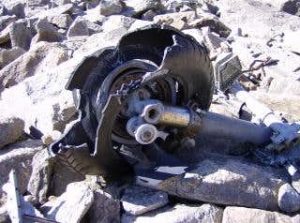
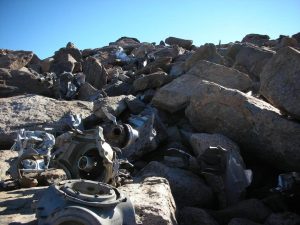 time, and the elements, went on, the paint wore off, and the shining aluminum allowed the plane to be located. The mountain was named “Bomber Mountain” in their memory. I can’t imagine the pain of loss the families of the crew must have felt knowing that their loved one had died, but to have no real idea what happened for two long years…must have been very hard to bear. Knowing where it all happened, while not removing the pain, at least brings peace.
time, and the elements, went on, the paint wore off, and the shining aluminum allowed the plane to be located. The mountain was named “Bomber Mountain” in their memory. I can’t imagine the pain of loss the families of the crew must have felt knowing that their loved one had died, but to have no real idea what happened for two long years…must have been very hard to bear. Knowing where it all happened, while not removing the pain, at least brings peace.

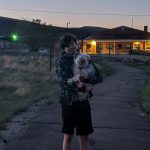 My grand nephew, Topher Spicer just finished his first year of high school…strange as it might have been. Never before has there been such an unusual ending to a school year, and all because of the Covid-19 virus. We experienced the never-ending spring break, home schooling in families that didn’t intend to home school, and online classes for all grades. Some kids did well, while others struggled with this new reality education. Topher did well. He likes school and learning, and finished his first year of high school with all A’s and B’s. It was something to be proud of.
My grand nephew, Topher Spicer just finished his first year of high school…strange as it might have been. Never before has there been such an unusual ending to a school year, and all because of the Covid-19 virus. We experienced the never-ending spring break, home schooling in families that didn’t intend to home school, and online classes for all grades. Some kids did well, while others struggled with this new reality education. Topher did well. He likes school and learning, and finished his first year of high school with all A’s and B’s. It was something to be proud of.
Topher also had an interesting year, in that he got a job…his first job. Most kids tend to go into retail or fast food for their first job, but Topher managed to land a really interesting job. It has me very impressed. He is 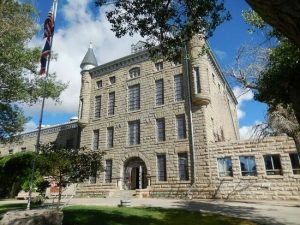 working as a tour guide for The Wyoming Frontier Prison. The prison opened in 1901 and could accommodate 104 prisoners. At that time there was no running water, electricity, and very inadequate heating. The 104 cells were in what is now Cell Block A. An addition completed in 1904 added 32 cells. A second addition, adding Cell Block B in 1950, helped alleviate overcrowding. Cell Block C was added in 1966, with 30 cells for the most serious cases. The prison closed in 1987 and became a historic site in 1988…setting the stage for Topher’s first job. Topher, being the innovative guy he is, loves his job, and enjoys making people laugh at the witty things he has come up with for some of the historical information. Many people find history boring, but Topher helps them understand how things were in a very different era, and makes it interesting while he’s at it…now that’s something to be proud of.
working as a tour guide for The Wyoming Frontier Prison. The prison opened in 1901 and could accommodate 104 prisoners. At that time there was no running water, electricity, and very inadequate heating. The 104 cells were in what is now Cell Block A. An addition completed in 1904 added 32 cells. A second addition, adding Cell Block B in 1950, helped alleviate overcrowding. Cell Block C was added in 1966, with 30 cells for the most serious cases. The prison closed in 1987 and became a historic site in 1988…setting the stage for Topher’s first job. Topher, being the innovative guy he is, loves his job, and enjoys making people laugh at the witty things he has come up with for some of the historical information. Many people find history boring, but Topher helps them understand how things were in a very different era, and makes it interesting while he’s at it…now that’s something to be proud of.
Topher is comfortable in his own company. He is an only child, and always finds ways to occupy his mind. 
 He and his mom, my niece, Andrea Spicer, are good friends, and even into his teenage years, they get along very well. Topher is her right-hand man, helping her with things she needs and doing it without complaint…ok, not too much anyway. Topher plans to spend high school building up his art and theatre credits, and then he is considering going to the University of Wyoming, or possibly to South Dakota. I know that whatever Topher decides to do, he will excel at it and continue to make his family proud. Today is Topher’s 15th birthday. Happy birthday Topher!! Have a great day!! We love you!!
He and his mom, my niece, Andrea Spicer, are good friends, and even into his teenage years, they get along very well. Topher is her right-hand man, helping her with things she needs and doing it without complaint…ok, not too much anyway. Topher plans to spend high school building up his art and theatre credits, and then he is considering going to the University of Wyoming, or possibly to South Dakota. I know that whatever Topher decides to do, he will excel at it and continue to make his family proud. Today is Topher’s 15th birthday. Happy birthday Topher!! Have a great day!! We love you!!
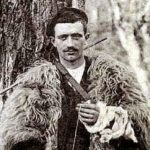 In a time when so much in our world is chaotic and serious, today seems like a good time to explore the lighter side of life. We have all seen the different feats performed for the Guinness Book of World Records. There are many people who attempt and fail to break the world record, and that is sad, because they have worked so hard to set it up, and it would probably take a long time to set it up again. Still, if a world record was easy to obtain, it wouldn’t really be so special.
In a time when so much in our world is chaotic and serious, today seems like a good time to explore the lighter side of life. We have all seen the different feats performed for the Guinness Book of World Records. There are many people who attempt and fail to break the world record, and that is sad, because they have worked so hard to set it up, and it would probably take a long time to set it up again. Still, if a world record was easy to obtain, it wouldn’t really be so special.
In the latter part of the nineteenth century, and long before the August 27, 1955 first publication of the Guinness Book of World Records, a local baker named Sylvain Dornon decided that he was going to make his mark on history. He decided that he was going to a bygone Landaise tradition of walking on stilts. Dornon was a baker in Arcachon, and I’m not sure what made him decide to take on such a feat, when he already had a decent business that needed his attention. Nevertheless, Dornon, who was born in 1858 in Salles, to the east of Arcachon and at the northern tip of the Landes, was fascinated with stilts. Normally, the use of stilts, or “échasses” as they were called, were primarily used by shepherds, because they were an easy way of maneuvering through marshy land and as a means of extending their field of vision when watching over their flock of sheep. Messengers and postmen, keen on time-saving and maintaining a steady step used stilts too, but as the wetlands became drier, the use of stilts began to die out. Dornon hated to see that period end, and decided to do something about it.
In the beginning of his quest, Dornon organized demonstrations and performances. In true street entertainment style, spectators were invited to make generous donations at the end of the show. The concept proved successful, but Dornon felt he and his stilts deserved greater exposure. So, he kicked things into high 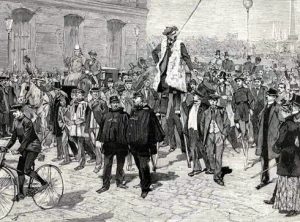 gear, in September of 1889, he travelled to Paris for the Exposition Universelle, and there, he walked up the steps to the second level of the Eiffel Tower. The stunt made Dornon almost a household word, for a while.
gear, in September of 1889, he travelled to Paris for the Exposition Universelle, and there, he walked up the steps to the second level of the Eiffel Tower. The stunt made Dornon almost a household word, for a while.
Dornon was inspired by the publicity he received, and by the tales of eccentric Russians travelling on foot from the western frontier of their country to France. He set himself a goal to stilt-walk all the way from Paris to Moscow, planning his arrival to coincide with a Franco-Russian exhibition being held there in May 1891. The trip would not be a free way to travel, so he set about securing financial backing from the magazine L’Illustration, began making two new pairs of stilts: one set measured 44 inches long and weighed about 7 pounds. The second, longer pair was 70 inches long, and was sent to Moscow, along with trunks of clothes.
Dornon was dressed in full Landais shepherd clothing…including goat-skin coat and beret, carrying a bag containing maps, a few spare clothes and a loaded gun…for safety. He was dressed in the authentic attire for the period he was portraying. Dornon set out from Place de la Concorde in Paris on March 12th 1891, surrounded by a 2,000-strong crowd of enthusiastic supporters! He walked an average of 37 miles a day, which I find amazing, considering that I walk an average of 15 miles a day, and I think that is an accomplishment. Even harsh weather conditions and poor road surfaces, didn’t slow him down. Dornon cruised through Reims, Sedan, Luxembourg, Koblenz, Berlin, Wilna and on to Moscow. He was joined periodically by walkers and cyclists for stretches of the route. Progress was also sometimes hindered by uncooperative policemen or children who would throw stones at him, not to mention downright hostile observers, notably in Germany where the sight of a Frenchman on stilts did not systematically prove popular. There always has to be someone 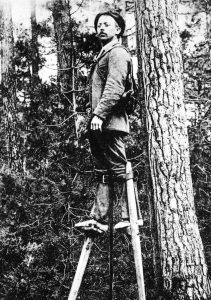 to ruin things. Still, Dornon never failed to find a local who had heard of his venture or a hotel bed to sleep in.
to ruin things. Still, Dornon never failed to find a local who had heard of his venture or a hotel bed to sleep in.
After 58 days and 1786 miles, Dornon arrived in Moscow preceded by a police cortege. He was hailed by a crowd chanting “Vive la France!” and treated to a champagne reception, although the staff at the French exhibition weren’t too impressed. Dornon wasn’t allowed to stilt-walk at the event and wasn’t even given a courtesy ticket…nice, he had to pay to get into his own reception. When the festivities were over, he boarded a train for the much-shorter trip home, where he went back to his job as a baker.
He still liked to take part in races and dance performances throughout the region up until his death in 1900 aged just 42. Dornon did leave a legacy…that of reviving a Landaise tradition which had already died out, and the concept he developed lives on to this day, with many échassier folk dance troupes continuing to entertain the masses.
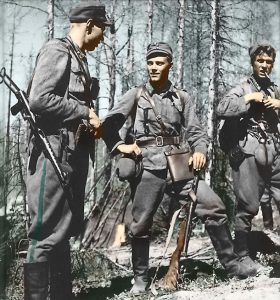 On June 26, 2003, a Green Beret was laid to rest at Arlington National Cemetery. That may not seem like such an unusual event, but in reality, it was very unusual. Lauri Allan Torni, aka Larry Thorne, was born in Viipuri, Finland on May 28, 1919. When he grew up, he entered the Finnish military service in 1938. He participated in the war between Finland and the USSR, proving himself in battle, and earning the rank of captain. It would appear that Torni would quite likely have a long and distinguished career in the military service.
On June 26, 2003, a Green Beret was laid to rest at Arlington National Cemetery. That may not seem like such an unusual event, but in reality, it was very unusual. Lauri Allan Torni, aka Larry Thorne, was born in Viipuri, Finland on May 28, 1919. When he grew up, he entered the Finnish military service in 1938. He participated in the war between Finland and the USSR, proving himself in battle, and earning the rank of captain. It would appear that Torni would quite likely have a long and distinguished career in the military service.
All that changed when Finland allied itself with Nazi Germany in 1941. In 1943, Torni put together a unit that was informally called Detachment Torni. This was an infantry unit that penetrated deep behind enemy lines, and they quickly made a reputation for themselves on both sides of the front for its combat effectiveness. For his part, Torni, for his Finnish military service was awarded 8 medals, to include the Mannerheim Cross, for action on July 9, 1944.
When his unit was demobilized, Torni joined a German SS unit in East Prussia and continued to fight the Russians, who at that time were the known enemy. During his time in the German SS, Torni was captured by the British, escaped a POW camp, and returned to Finland, where he was arrested for his German army service. I’m sure that at this point he wondered what was going on. I would think he realized the the German SS was his whole problem, but like many, he was fooled by Hitler and the Nazi party. After being pardoned in 1948, Torni secretly traveled to Sweden, masqueraded as a Swedish seaman, and sailed to the vicinity of Mobile, Alabama,  where he jumped overboard and made it to land. As most people know, getting to land was an opportunity to seek asylum, which Torni did. He was granted residency in 1953 and because he wanted to be loyal to his new country, Torni, now going by Larry Thorne joined the Army. Again, he proved himself in battle, and eventually became a Green Beret assigned to Special Forces. Torni, now Thorne was an incredible soldier, and very loyal to his nation and his fellow soldiers. He served in various high profile capacities around the world in his time of service as a Green Beret.
where he jumped overboard and made it to land. As most people know, getting to land was an opportunity to seek asylum, which Torni did. He was granted residency in 1953 and because he wanted to be loyal to his new country, Torni, now going by Larry Thorne joined the Army. Again, he proved himself in battle, and eventually became a Green Beret assigned to Special Forces. Torni, now Thorne was an incredible soldier, and very loyal to his nation and his fellow soldiers. He served in various high profile capacities around the world in his time of service as a Green Beret.
In 1963 when he was 44 years old, Thorne was deployed to Vietnam as an advisor, but two years later Torni’s remarkable career came to an end when his helicopter crashed during a secret mission. It was a tragic end to a short lived, be remarkable career. His remains were not located until 1999. Finally, on June 26, 2003, a multi-national hero and in the end, a celebrated Green Beret was laid to rest. He was an amazing soldier.
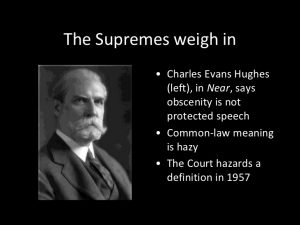 I sometimes think that I am from a different era…one where people didn’t use so many obscenities. In reality, I am from that era, because on June 24, 1957, when I was just a 14 months old, the United States Supreme Court ruled that obscenity is not protected by the First Amendment to the Constitution, which guarantees free speech and freedom of the press. Call me old fashioned, but when I hear someone screaming at their own child, using every obscenity known to man, it makes me cringe. Calling our children such horrible names, can’t possibly be a good way to teach them self esteem. The United States Supreme Court agreed, according to Roth v. United States, a case decided in 1957. Samuel Roth of New York City was convicted of mailing obscene materials. On appeal his conviction was affirmed by the Supreme Court, which held that obscenity was not protected by the First Amendment to the United States Constitution. The court ruled that “material is obscene if, to the average person applying contemporary community standards, the dominant overall theme appeals to prurient interest.”
I sometimes think that I am from a different era…one where people didn’t use so many obscenities. In reality, I am from that era, because on June 24, 1957, when I was just a 14 months old, the United States Supreme Court ruled that obscenity is not protected by the First Amendment to the Constitution, which guarantees free speech and freedom of the press. Call me old fashioned, but when I hear someone screaming at their own child, using every obscenity known to man, it makes me cringe. Calling our children such horrible names, can’t possibly be a good way to teach them self esteem. The United States Supreme Court agreed, according to Roth v. United States, a case decided in 1957. Samuel Roth of New York City was convicted of mailing obscene materials. On appeal his conviction was affirmed by the Supreme Court, which held that obscenity was not protected by the First Amendment to the United States Constitution. The court ruled that “material is obscene if, to the average person applying contemporary community standards, the dominant overall theme appeals to prurient interest.”
These days, we are bombarded with obscenities and profanities…everything from the f-bomb to the names we 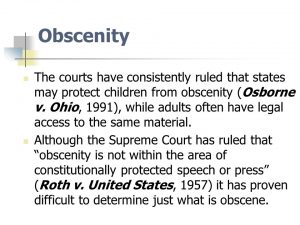 call people we don’t particularly like. Television shows use obscenities on just about every show, and our children are growing up to think that not only is it ok to call people such names, but its ok to be constantly angry…and to let everyone around you know it. It seems to me that as all the obscenities became commonplace, so did anger. And anger breeds hate, which in turn breeds things like road rage, bullying, and even murder.
call people we don’t particularly like. Television shows use obscenities on just about every show, and our children are growing up to think that not only is it ok to call people such names, but its ok to be constantly angry…and to let everyone around you know it. It seems to me that as all the obscenities became commonplace, so did anger. And anger breeds hate, which in turn breeds things like road rage, bullying, and even murder.
Now, that we have the freedom to say the things that we do, another problem has come to light…hate speech. What is hate speech? It never used to be a thing, although it did exist…it just didn’t have a name, per se. So we have somehow come full circle, to a degree. While the Supreme Court used to say that we can’t use obscenities or profanities, and then suddenly we could, now we find ourselves with the necessity to decide if something said is “hate speech” or not, and if it is, then has the right to free speech been denied. Why is one thing different than the other? Believe me, I don’t like either kind of talk…hate or obscene, but if one is “illegal” then shouldn’t the other also be “illegal.” Or, should we have any say at all? It is a vicious circle to be sure. I guess that in reality, it is a moral issue. We have slipped so far from the moral values of our ancestors that our 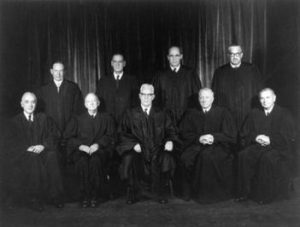 world almost doesn’t even resemble that of the era I was raised in, and certainly bears no resemblance to the era of our ancestors. While I can’t say exactly how to solve this dilemma, I think that maybe the best solution lies within each of us. Maybe we need to walk away from the situations that make us angry. Maybe we need to be more careful of the speech and behaviors that we show to our children. Maybe we need to teach our children that other people have a right to their opinion too, and it is not up to us to be their verbal police. Maybe we need to take offense less, and show compassion more. No matter what the ultimate solution is, there is no doubt in my mind that it begins in the human heart.
world almost doesn’t even resemble that of the era I was raised in, and certainly bears no resemblance to the era of our ancestors. While I can’t say exactly how to solve this dilemma, I think that maybe the best solution lies within each of us. Maybe we need to walk away from the situations that make us angry. Maybe we need to be more careful of the speech and behaviors that we show to our children. Maybe we need to teach our children that other people have a right to their opinion too, and it is not up to us to be their verbal police. Maybe we need to take offense less, and show compassion more. No matter what the ultimate solution is, there is no doubt in my mind that it begins in the human heart.
 Adolf Hitler was a greedy man. From the time he decided to get into politics, he planned on controlling Germany, and eventually the rest of the world. Hitler was appointed chancellor on January 30, 1933. It didn’t take long for him to begin his fundamental change of Germany. His plan was always to be a dictator, but it’s hard to do that when the country holds national elections periodically. That said, the first thing Hitler needed to do was to make Germany a one-party state. That way, they could have the pretense of holding elections, but only one candidate would run. So, on June 22, 1933, Hitler banned all other parties, thereby making Germany a one-party state.
Adolf Hitler was a greedy man. From the time he decided to get into politics, he planned on controlling Germany, and eventually the rest of the world. Hitler was appointed chancellor on January 30, 1933. It didn’t take long for him to begin his fundamental change of Germany. His plan was always to be a dictator, but it’s hard to do that when the country holds national elections periodically. That said, the first thing Hitler needed to do was to make Germany a one-party state. That way, they could have the pretense of holding elections, but only one candidate would run. So, on June 22, 1933, Hitler banned all other parties, thereby making Germany a one-party state.
Of course, even Hitler couldn’t get this done that easily. He had to ease into it a bit. In March 1933, he pushed through the Enabling Act, which was an amendment to the Weimar Constitution, passed in the Reichstag by a vote of 444 to 94. This new amendment allowed Hitler and his cabinet to pass laws…even laws that violated the constitution…without the consent of the president or the Reichstag. It was the beginning of a very dangerous era in German history. A two-thirds majority was required to pass the bill, so the Nazis used intimidation tactics, as well as the provisions of the Reichstag Fire Decree to keep several Social Democratic deputies from attending, and the Communists had already been banned. It was a rigged passing, and should never have been allowed to happen, but the people didn’t understand the ramifications. Then, on May 10th, the government seized the assets of the Social Democrats. The party was banned on June 22, 1933. On June 21st, the SA raided the offices of the German National People’s Party, who were at one time, their coalition partners. That party was forced to disband on June 29th. It didn’t take long for the remaining major political parties followed suit. On July 14, 1933, the transition was complete when Germany became a one-party state with the passage of a law decreeing the Nazi Party to be the sole legal party in the country. It was further declared that the founding of new parties was illegal, and all remaining political parties in Germany were banned.

The Enabling Act would subsequently serve as the legal foundation for the dictatorship the Nazis established. Further elections in November 1933, 1936, and 1938 were Nazi-controlled, with only members of the Party and a small number of independents elected. Then, Hitler banned all other parties making Germany a one political party country, the National Socialist party was the only party that then existed in Germany. This change came after several other changes in 1933, including creation of the German Secret State Police (Gestapo) and the banning of Trade Unions. The death penalty was declared for anti-fascists. Today, Germany is a multi-party nation.
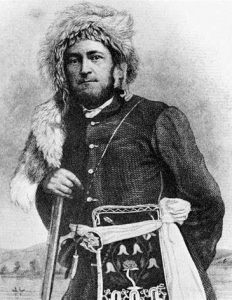 Many people who love the era of the Cowboys and Indians, also find themselves intrigued by the Mountain Men. These men were the epitome of the “wild” west. The Mountain Men were often what many might call “social rejects,” because they lived in the wilderness, hunted and fished to sustain themselves, and were often trappers who sold their furs to supplement their living. All that seems rather normal, but they were also reclusive, and often had long hair and a bushy beard. I suppose that many people would think that our opinion of the mountain men was discriminatory, but we have always had some concerns over those who were so very different. Maybe we even associated the mountain men with lawlessness. They often lived in the wilderness, because the were non-conformists when it came to the law. It wasn’t that they wanted to rob banks and kill people, but rather that they wanted to be free to live their lives the way they saw fit, without all the rules and regulations of society.
Many people who love the era of the Cowboys and Indians, also find themselves intrigued by the Mountain Men. These men were the epitome of the “wild” west. The Mountain Men were often what many might call “social rejects,” because they lived in the wilderness, hunted and fished to sustain themselves, and were often trappers who sold their furs to supplement their living. All that seems rather normal, but they were also reclusive, and often had long hair and a bushy beard. I suppose that many people would think that our opinion of the mountain men was discriminatory, but we have always had some concerns over those who were so very different. Maybe we even associated the mountain men with lawlessness. They often lived in the wilderness, because the were non-conformists when it came to the law. It wasn’t that they wanted to rob banks and kill people, but rather that they wanted to be free to live their lives the way they saw fit, without all the rules and regulations of society.
One such mountain man, was Joe Meek, who was born in Virginia in 1810. Meek was a friendly and relentlessly good-humored young man. Unfortunately, Meek did not have a the same interest in school, that he did to be a friendly, funny guy. In reality, his biggest problem was that he had too much energy to sit still and learn. After finally giving up on schooling, at 16 years old, Meek moved west to join two of his brothers in Missouri. Meek later found a need to read and write, and so taught himself, but his spelling and grammar were said to be “highly original” throughout his life.
In early 1829, Meek joined William Sublette’s ambitious expedition to begin fur trading in the Far West. This was the perfect lifestyle for Meek, and he found himself flourishing. Meek traveled throughout the West for the next decade, thoroughly enjoying the adventure and independence of the mountain man life. Meek was an average man, standing 6 feet 2 inches tall. He wore a heavy beard, and became a favorite character at the annual mountain-men rendezvous, where he regaled his companions with humorous and often exaggerated stories of his wilderness adventures. Meek, who was a well known grizzly hunter, claimed he liked to “count coup” on the dangerous animals before killing them, a variation on a Native American practice in which they shamed a live human enemy by tapping them with a long stick. Meek also claimed to have wrestled an attacking grizzly with his bare hands, before finally sinking a tomahawk into its brain. I suppose it might have been a tall tale, but more than one mountain man hs fought a bear. Some have won, and some have not had the same outcome…sadly.
Meek may have been a misfit in society, but he had good relations with many Native Americans, and in fact, he married three Indian women during his lifetime, including the daughter of a Nez Perce chief. Still, that good relationship didn’t prevent him from getting into some squabbles with the tribes. Many of the Indians didn’t like the incursion of the mountain men into their territories, and periodically, things got hostile. In the spring of 1837, Meek was nearly killed by a Blackfeet warrior who was taking aim with his bow while Meek tried to reload his Hawken rifle. Luckily for Meek, the warrior dropped his first arrow while drawing the bow, and the mountain man had time to reload and shoot.
Finally, in 1840, Meek saw that the golden era of the free trappers was ending. He decided that it was time for a “career change.” Meek and another mountain man, along with Meek’s third wife guided one of the first wagon trains to cross the Rockies on the Oregon Trail. Once there, Meek settled in the lush Willamette Valley of western Oregon, became a farmer, and actively encouraged other Americans to join him. He could see that  times were changing. In 1847, Meek led a delegation to Washington DC, asking for military protection from Indian attacks and territorial status for Oregon. After the long journey, Meek arrived in Washington DC “ragged, dirty, and lousy.” Nevertheless, he became something of a celebrity in the capitol…maybe a little bit like “Crocodile Dundee.” Meek was a novelty, and the Easterners relished the boisterous good humor Meek showed in proclaiming himself the “envoy extraordinary and minister plenipotentiary from the Republic of Oregon to the Court of the United States.” The trip was quite successful, and Congress responded by making Oregon an official American territory and Meek became a US marshal.
times were changing. In 1847, Meek led a delegation to Washington DC, asking for military protection from Indian attacks and territorial status for Oregon. After the long journey, Meek arrived in Washington DC “ragged, dirty, and lousy.” Nevertheless, he became something of a celebrity in the capitol…maybe a little bit like “Crocodile Dundee.” Meek was a novelty, and the Easterners relished the boisterous good humor Meek showed in proclaiming himself the “envoy extraordinary and minister plenipotentiary from the Republic of Oregon to the Court of the United States.” The trip was quite successful, and Congress responded by making Oregon an official American territory and Meek became a US marshal.
Strangely, considering his anti-social beginnings, Meek returned to Oregon and became heavily involved in politics, eventually helping to found the Oregon Republican Party. He later retired to his farm, where he died on June 20, 1875 at the age of 65.

